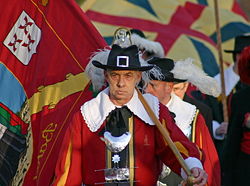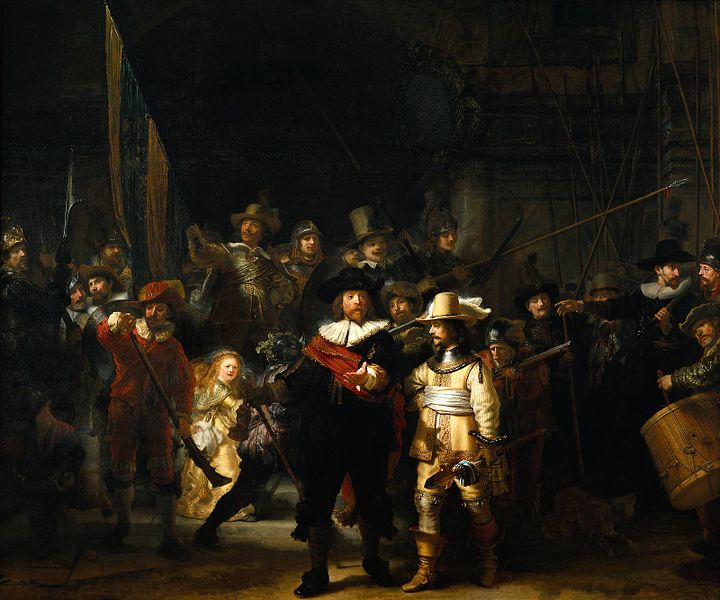Our story
This chapter
|
|
 heraldry, n, Science of a herald; armorial bearings; heraldic pomp Last revision: April 9, 2008 Bearing personal armorial insignia on shields and banners became widespread in feudal times and was a wise thing to do. A knight on the battlefield, with face covered by iron, somehow had to be recognized quickly. During the Crusades, it became custom to wear these markings on the surcoat that covered a knight's mail; hence the term "coat of arms." 3 Insignia were not hereditary at first and knights were free to choose their own symbols, as were wealthy individuals, families, towns, lordships, abbeys and other groups who had gained the favor of the reigning monarch. However, with duplication and growing confusion, a simple form of identification became rather a mess on the ladders reaching up to enhanced social status. 4 A coat of arms is not defined by a picture, but by a description, called a blazon. Here are the rules for creating a blazon: 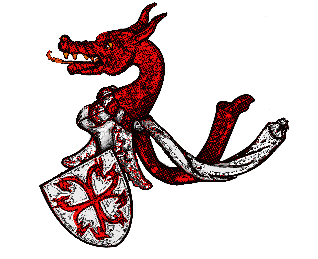 A blazon for the Huyns von Amstenrade that goes back to 1370-1395 reads: "d'argent à la croix ancrée et gringolée du gu" with "une tête de dragon du gu. tortil d'argent et gu." (Source: "L'armorial universel du héraut Gelre" by Claes Heinen, roi des armes des Ruyers (J.B. Wolters, Groningen, 1890). 7 Heraldic structure became standardized in the middle of the 12th century. By this time, coats of arms were inherited by the offspring of armigers (persons entitled to use a coat of arms) across Europe. In the late Middle Ages and the Renaissance, heraldry became a highly developed discipline, regulated by professional officers of arms. As its use in jousting became obsolete, coats of arms remained popular for visually identifying a person in other ways--impressed in sealing wax on documents, carved on family tombs, and flown as a banner on country homes. The first work of heraldic jurisprudence, De Insigniis et Armiis, was written in the 1350s by Bartolus de Saxoferrato, a professor of law at the University of Padua.* 8 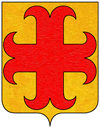 Shown here is a croix ancrée. Change the ancors to doublets of snake heads and we have a croix ancrée et gringolée* ("Schlangenkreuz" in German). 9 Coats of arms may or may not be embellished with a crest. Such a crest would reflect a crest made of wood or boiled leather worn on top of a knight's helmet. Typically, the crest corresponds to the charge on the shield. In the example given, the crest is a dragon head and corresponds to the winged snakes on the shield. Below the crest we see a wreath and mantling. The mantling reflects the mantle often worn by a knight in shining armor to shield him from the burning sun. 10 The portrait of Johann George Merckelbach (1609-1680) we saw in Chapter 2 shows two coats-of-arms. The one at the bottom his; the one above of his employer, the Marquis of Baden and Hochbergen, etc., with numerous charges attesting to his exalted position. Complexity of a single charge begins with the expansion of family. Upon his father's death, an eldest son inherits his father's coat-of-arms, but the others have it differentiated by labels (which are small, added designs) or changes in colors. A married daughter acquires a coat-of-arms that is split with her husband's to one side and her father's to the other, a process called impaling. A few generations of impaling and a coat-of-arms becomes complex indeed. 11  There is a story circulating that the Merckelbachs and the family of the famous Flemish painter Jan van Eyck are related. This sketch from a document, said to be dated around 1300, confirms the validity of the rumor; in fact, there appears to exist a double relationship. (1) is the coat-of-arms of the painter's father; (2) that of his grandmother on his father's side which exemplifies impaling; (3) that of the mother's mother; (4) that of the mother's father. A branch of the Merckelbach and the Van Eyck families lived in the same region. Jan van Eyck, named "the leading painter of his day," was born before 1395 and died in 1441 and was buried in the St. Donaas Church in Brugge (Bruges). 12 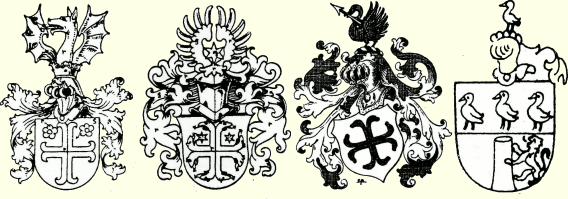 From left to right: The coat-of-arms of Reinhard Merckelbach (t.1.2b.2a.1b.2a/b ?), 1590, exemplifies labelling with cinquefoils. That of a Wilhelm Merckelbach, Baumeister der Hirtzschützen, 1724, is labelled with six-pointed stars and the crest is a winged star. The coat-of-arms of a Merckelbach from Heerlen; a swan with an arrow has taken the place of a dragon. The fourth item of heraldry is from a Merckelbach said to have acquired Stockis, in the village Thimister, as fief. Not only is the dragon gone from the crest, but so is the Schlangenkreutz disappeard from the escutcheon. 13 For further study: Site by Dr. Bernhard Peter. Bibliography
From: http://en.wikipedia.org/wiki/Heraldry. This source provides additional informative links. return fn1 For a rich source of heraldic nomenclature click here. return fn2 Mostly a condensed translation from Carlo Bijvelds, "Van 'Zuipschutjes' tot Cultuurdragers: Verval en herstel van de Brabantse schuttersgilden tijdens het Interbellum." Brabants Heem, 1998. return fn3 |
--
| top of page |
|
Page maintenance:
Page format:monh xx, 2015
Story edit:
To be checked for timeliness:
¶ none
Reminders:
¶ none
Linkcheck: not done
XHTML verify: not done
Backups: month. 25, 2011

